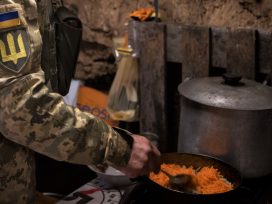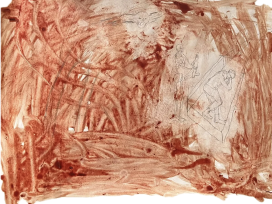The way home
When a neighbourhood collapses into a warzone, from one day to the next, citizens become refugees. Securing safety and caring for those who remain creates a dual burden. Ukrainians, turning to their diaspora, have experienced both support and tension. Returning or remaining has become a political and deeply personal dilemma.
In the immediate aftermath of Russia’s full-scale invasion of Ukraine in 2022, it seemed that everything had changed and would never be the same again. When Poland, run by a distinctly anti-refugee government,1 opened its gates to millions, many Europeans dropped everything to go to the border and volunteer. The solidarity with Ukraine was overwhelming. It gave hope.
The same was true among Ukrainians. The existential threat and consequent ‘rally ‘round the flag’ effect produced the highest-ever levels of social cohesion, previously unimaginable from Ukraine’s diverse patchwork of historical trajectories, languages, ethnic and religious identities, and political differences. For once, it seemed everyone was going through the same experiences, and had opened their hearts and minds to others: westerly cities like Lviv hosted refugees from the southeast; urban residents escaped to villages; the young lived with the old in safer regions. Whether rich or poor, workers or intelligentsia, Christians, Muslims or Jews, those dominantly Russian or Ukrainian speaking, all ended up shoulder to shoulder in the trenches or shelters, as the barrage of Russian missiles threatened indiscriminately. It seemed that old social cleavages were a thing of the past.
However, it now looks like all these effects were mostly short-term. With the war dragging on, its experiences have become more diverse and its effects more uneven, producing new cleavages and social hierarchies. Three macro groups have emerged: those who have served, those who stayed and those who left. Tensions and judgements characterize the relationships between these groups, and increasingly within each division.
Gaps in understanding, due to different experiences of war, coupled with the high emotional charge, physical exhaustion and overall toll on people, have produced social tensions and deepened certain divides over time. Rallying ‘round the flag can’t be perpetuated forever – not only in support of the government but also for interpersonal solidarity. And the disintegration of social cohesion started sooner for the diaspora than it did for society back in Ukraine – hypothetically, due to the absence of an immediate threat.
As a migrant myself both before and after the full-scale invasion began,2 I am familiar with how perceptions of Ukrainian who have emigrated have changed over time. Of all countries, Poland, where I conducted my research on Ukrainian experiences of living abroad, has received the most Ukrainians: at least 1.3 million from 2014-2021,3 which doubled in 2022.4 Interviewing labour migrants from Ukraine in 2021 and again at the end of 2022 revealed that resentments are growing; the processes of emigration and reception, and their significance, have been very different for old, labour migrants and newly arrived refugees.
The underrated role of the diaspora
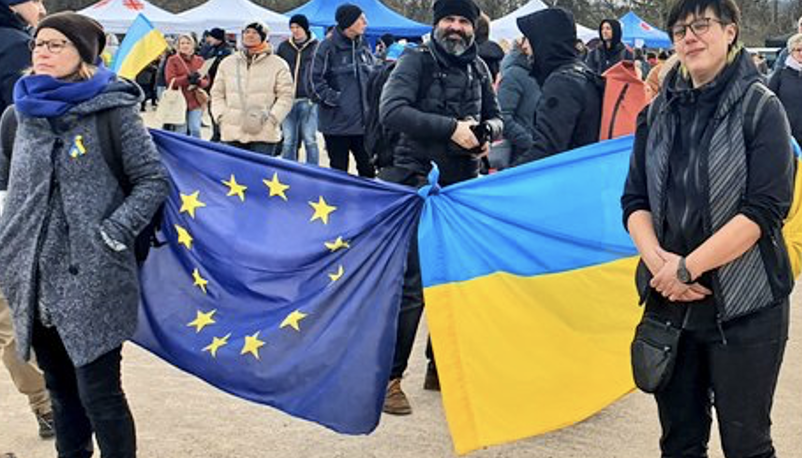
Demonstration in Prague, April 2022. Image courtesy of the author
Even though the initial mass mobilization subsided after a few months, the role of the existing Ukrainian diaspora in managing the crisis cannot be understated. It was migrant networks that were the single most crucial factor enabling such a warm welcome – as it is often put in the media – for such an enormous number of Ukrainians fleeing the war. As Ukrainian migration researcher Olena Fedyuk summarizes: ‘If we look at UN Refugee Agency’s statistics, the number of people who moved to a country often mirrors the number of labour migrants that already existed in that country.’ She further points out: ‘labour migrants, who are often portrayed as apolitical, have played a tremendous role in supporting this mobility. Yes, Europe opened borders, and a lot of local initiatives provided initial relief, catastrophe relief, but it’s really the existing networks of labour migrants that have received the main financial, social and moral pressure.’ Both the statistics and the interview responses I received confirm this for Poland.
Since then [24.02.2022], I haven’t slept in my bed alone. There were always some friends who came and drove further, and then my mother arrived. (Anna, a Ukrainian lawyer in Krakow).
Without fail, every respondent from the existing diaspora was active in one way or another; each had family or friends who had left Ukraine because of the full-scale invasion. When labour migrants were asked what guided refugees choices on their destination, the most frequent answer was that they had family in that country. This effect then snowballed, creating set patterns of migration in 2022. And when the heaviest burden is placed on individuals without enough institutional support, it’s only a matter of time before tensions build.
Refugees under suspicion
Various groups simultaneously judge Ukrainians refugees: host societies display fatigue; exhausted people back home, sometimes including family members; and, perhaps surprisingly, Ukrainians who migrated earlier. All kinds of myths about refugees inhabit public discourse. One of my diaspora respondents compared refugees to ‘parasites, who suck on social assistance’. Another called them ‘lucky’. When one reads comments from the social media groups of Ukrainians abroad, the language is sometimes even stronger and has been so since refugees arrived. There is a noticeable feeling of resentment at perceived injustice and inequality: refugees are receiving aid and opportunities ‘for nothing’, which earlier migrants did not get when they arrived in Poland.
Refugees are in a compromised position amidst the asymmetry of migration networks. They are repeatedly told to remember their place, be humble and grateful, and not dishonour Ukraine and fellow Ukrainians; earlier migrants, especially those permanently established in their host country, are afraid for their reputation, which is a constant struggle to maintain. Shame is expressed more often than empathy, sympathy or grief for fellow Ukrainians fleeing war. A lot of anger and distrust is directed at what appears to be an inappropriate recipient. And refugees often experience a double burden: they are expected to provide emotionally if not financially for those who remained in Ukraine from what is considered a privileged position abroad.
Any definitive statement about what Ukrainian refugees are like, from a displaced population of 8 million,5 has to be a misleading generalization. Being settled in over 40 countries,6 any definitive statement on the conditions they live in has to be a misleading generalization, too. People, and their situations, simply differ too greatly. While some may drive expensive cars, others rely on volunteers like Austria-based Tanja Maier organizing the distribution of 50 euro supermarket coupons to be able to feed their kids. Some have a thriving career, a partner and a home waiting for them in a relatively safe town. Others from places like Kharkiv may have lost everything. Those from places like Mariupol have nowhere to return to. Stereotyping isn’t helpful.
The gender gap
Ukrainian men who live abroad and those who have otherwise avoided the draft face particular condemnation. While, for respondents, being Ukrainian and associating with a home country at war instilled a new sense of national pride in collective achievements on the battlefield and in resistance, it also often provoked a feeling of shame, guilt and self-judgement for not returning to fight. As martial law restricts Ukrainian men from going abroad, male emigrants cannot see friends and family back home without their travel becoming a one-way ticket. While mental health support has so far been largely directed at women, the mental health impact of the war in this respect may be higher on men.
For women, the war and its resulting imbalances regarding mobility have both been empowering and perpetuated gender-role inequalities. On the one hand, women have had to take up more leadership in activism and diplomacy, while men are hindered. On the other hand, women have been pushed back into the role of caretakers: evacuating children and senior family members; often not having the opportunity to work; and subject to a system that incentivizes vulnerability.
Who will return?
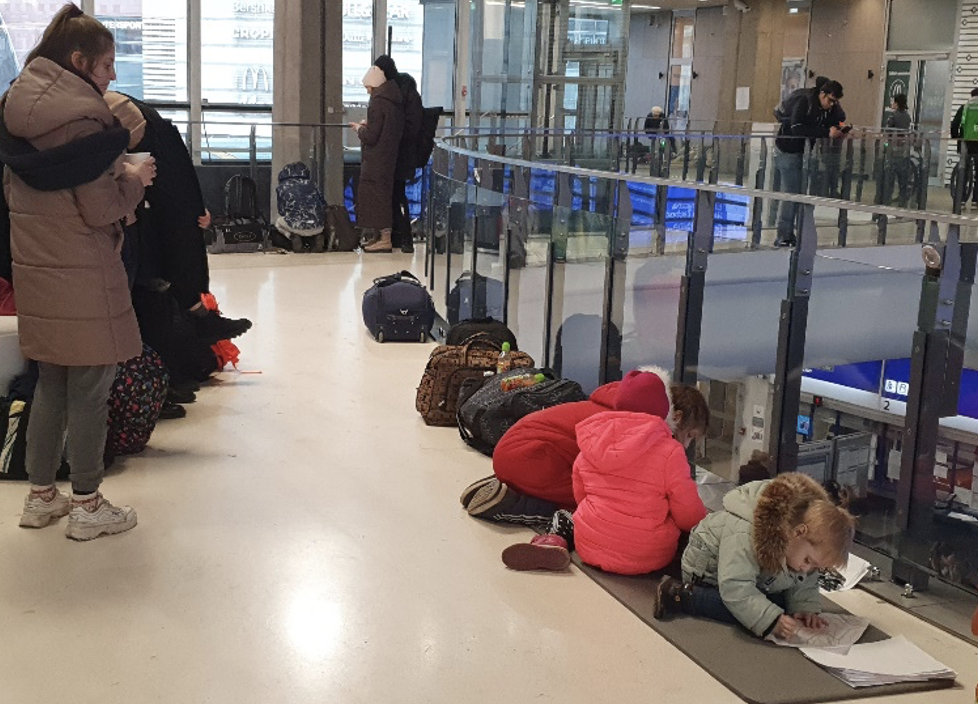
Warsaw train station, March 2022. Image courtesy of the author
It’s a loaded question. Having lost millions who have fled (almost half of which are children),7 hundreds of thousands in combat and attacks, and with a plummeting fertility rate due to instability, Ukraine’s demographic prognosis looks bleak. This decrease in population carries significant risks for the country’s economy and overall prosperity; rebuilding after the war will require skilled hands and brains. Before 2014 the industrial Donbas in particular and the south-east in general were Ukraine’s most populated regions and biggest contributors to the national economy. Now, given the 5 million internally displaced persons,8 Donbas’s industry is in ruins, agriculture in the south is challenged by mine pollution and the Kakhovka dam’s demolition, and the coastal and Russian borderland areas are still threatened by artillery fire; the socio-economic map of Ukraine is flipping.
I asked my respondents from the diaspora about their thoughts on returning to Ukraine. On the whole, the full-scale war has not significantly altered the plans of emigrants but has strengthened their pre-existing positions. For those who wanted to settle abroad for a better quality of life, the destruction of war has given them greater conviction to do so. For those who wanted to return and contribute to Ukraine’s development, the war has strengthened their resolve. Despite raising grievances of refugees abusing aid, several respondents have applied for humanitarian visa programmes in other countries and had either already moved or were planning to do so. It was something they had already wanted and the liberalized migration regimes for Ukrainians in 2022 presented them with the opportunity to do so.
There is a noticeable difference in how refugees and economic migrants choose host destinations. Refugees tend to base their decisions on practical urgent needs: they often move to a location with available accommodation. Among labour migrants, many are ‘dreamers’: recipients who shared their plans of moving on to a different country often state stereotypical images of Western countries as their reasons.9 Leaving Poland is often associated with avoiding increasingly illiberal populist politics.
Statistics show a high, albeit declining, percentage of migrants wanting to return to Ukraine: 63%, according to a recent survey.10 From interactions with Ukrainian refugees in Europe, I would challenge these numbers. Social pressure and shame drive many to give the ‘correct’ answer instead of sharing their actual thoughts, their doubts. The quantitative nature of such surveys doesn’t reveal when or under what circumstances people are willing to return and what it means to them.
From my research, many respondents discussed the possibility of returning to Ukraine after the war. However, the prospect was always discussed in a hypothetical manner. I spoke to a refugee who stated proactively at a public event that she wanted to return. In private after the event, she told me when she was planning to do so: ‘After my child goes to university – I want him to receive a European diploma’; when asked how old her child was, she replied, ‘He’s in fifth grade.’ Another refugee who fled with a child was always vague about her plans. Then I noticed she had her library shipped from Kyiv – that seemed a stronger statement of intent than anything expressed in words.
Those who admitted not wanting to return to Ukraine were always very negative about Ukraine’s future. Having hope, or having lost it, was probably the single biggest predictor of a person’s intentions. It might be that migrants adopt a very negative lens of their home country to rationalize having uprooted themselves. Alternatively, it might be that those who are not optimistic about positive changes in their home country are more likely to emigrate in the first instance. Sometimes, very particular and personal negative experiences like being bullied at school can be extrapolated to negative associations ascribed to the whole country and, therefore, the desire to leave.
Most often, however, less directly personal justifications such as corruption, low salaries or high inflation are given for not wanting to return. While broad factors do impact an individual’s situation, they are less likely to translate as decisive factors in decision-making. However, it does seem that impersonal reasons are more acceptable to voice publicly; when a higher force exerts control over your situation, you can be excused for not doing the ‘right’ thing. Saying out loud that you don’t want to return because you have found a higher paid job abroad, or that the husband waiting for you at home is abusive, or that you no longer have to deal with family-in-law you dislike, or that you simply found a new partner who won’t be drafted and can go on holiday abroad with you is socially unacceptable among Ukrainians. Nevertheless, it is these individual circumstances that are decisive and should be kept in mind for any policy that incentivizes returns.
Of note is the estimated third of Ukrainian refugees that have already returned. For those who are still abroad, the likelihood of them returning is dropping with every day that the war lasts. The longer refugees adapt to their host country and build a life there – with children attending school and learning a new language, for example – the more it will be traumatic to leave once again. In addition, the longer the war lasts, the more homes, schools and hospitals are destroyed, the less there is to go back to. How realistic rebuilding everything, and fast, especially close to the Russian border, remains a big question. The best way to help Ukrainian refugees who are willing to return would be strengthening air defence over cities and critical infrastructure so that schools and businesses aren’t too disrupted, helping to mitigate for and ideally prevent winter blackouts. The goal of any refugee is to stop being a refugee, an outsider, which, for some, means returning home to a peaceful place.
Legal precarity
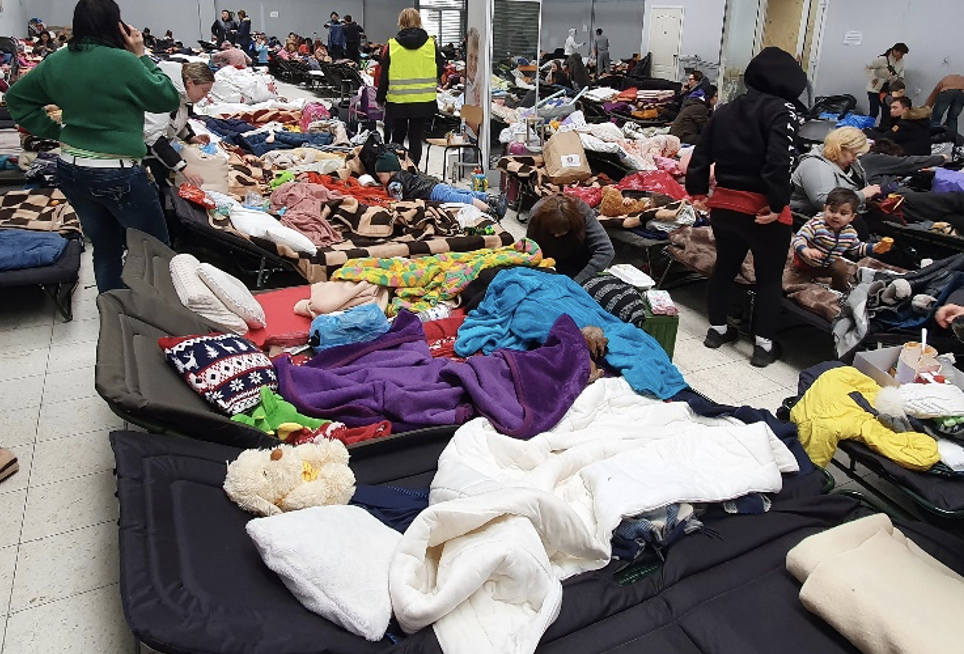
Refugee camp at Korczowa border crossing, March 2022. Image courtesy of the author
For others, the transition away from their refugee status is by fully establishing their life abroad, securing ongoing stability and finding acceptance. The waiting and uncertainty is often the most exhausting. We commonly call Ukrainians who fled the war refugees. However, legally speaking, Ukrainians were granted temporary protection status and not asylum. The key word here is ‘temporary’. The EU directive, an initial blessing, could well turn into a hinderance: allowing for a maximum of three years’ protection, there is no clear understanding of what will happen to Ukrainian refugees when the deadline expires; and the war is already nearing its second anniversary.11 Implementation of the directive differs from country to country.12 Yet nowhere in the EU does the time Ukrainians spend in member states under temporary protection count towards EU long-term residence permits. With the issue of migration being highly politicized, European and other elections next year may further complicate the solution to this question, carrying potential risks for both refugees and their receiving societies. For the refugees, the politically conditioned discourse of hospitality rather than rights makes their position precarious; sometimes hospitality turns into ‘hostipitality’, as Derrida once put it.13 For the receiving society, there is the risk that right-wing populist actors could capitalize on rising resentment, as has happened in many countries previously after receiving large numbers of refugees, as in Germany after 2015.14
In several countries, the proposed solution for refugees who want to stay is a temporary residence permit based on employment: a labour migration regime for Ukrainians displaced by war. However, this approach would leave out the vulnerable, the elderly and the sick. It would also not serve many women with children, who constitute the majority of Ukrainian refugees, and often have no access to affordable childcare, and therefore, in the absence of family abroad, cannot enter the labour market. These people live in fear of what their future will look like. Whether Ukrainians return or not will depend heavily on which policy instruments host governments decide to implement. Many refugees come from frontline and occupied areas. As long as the Ukrainian government doesn’t have sufficient resources to provide for internally displaced persons, it should lobby for the protection and humane treatment of its citizens abroad.
Ukraine might one day need its own immigration policy. When the time for broad-scale rebuilding comes, more than returning women and children will be needed to cover the task at hand. Ukrainians will need to remember the hospitality they were given abroad and extend the same or do better. But with unemployment at almost 20%, having doubled since the full-scale invasion, this isn’t a burning issue at present. Decent wages are, however.
Belonging, representation and agency
Those respondents to the study who were the most eager to return to Ukraine were those for whom it is important to be part of civil society and have the agency to influence social and political change – something they don’t feel they have in a foreign society yet. In addition to the hopes they have for positive change in Ukraine after the war, they feel a sense of ownership and responsibility over reconstruction:
I don’t feel that I can live in Poland all my life. Because in Poland, same-sex marriages are not legalized. In terms of equality for me as a gender minority, I wouldn’t feel comfortable, so I would go somewhere else. And it is very possible that it would be Ukraine. Even if same-sex marriages aren’t legalized in Ukraine, even if there are no civil partnerships, it would be more comfortable for me to live in Ukraine because I could fight for it. I would like to fight for them to be legalized in Ukraine. … Because I don’t feel that I am responsible for Polish civil society. I am responsible for Ukrainian society because I am part of it. (Ihor, PhD student from Luhansk)
Such a statement reflects a strengthening of Ukrainian civic national identity, and not only because of a common military threat. Existing research and my data suggest that the common and participatory experiences of modern Ukraine’s three revolutions15 have fused Ukrainian identity with active citizenship: ‘enhanced solidarity with compatriots, increased readiness to defend Ukraine or work for Ukraine, and increased confidence in the people’s power to change the country for the better … Some believe that the national transformation and consolidation started on the Maidan itself, in a readiness to defend the common cause and support other people fighting for it; people who came to be perceived as Ukrainians rather than merely fellow protesters’.16 Collective resistance to the 2022 invasion, which included all segments of society, solidified these tendencies.
Coming to terms with the present
Data from this research project show that, in general, the full-scale war doesn’t seem to have radically changed socio-political realities yet. Rather it has deepened existing tendencies and caused further polarization. There is evidence of both stronger social cohesion and reconciliation, breaking stereotypes, and deepening divides, including new social tensions. However, the ripple effects we will only be able to appreciate with hindsight.
While there remains a lot of uncertainty about the future of the Ukrainian migrant population across Europe, one thing is clear: such tectonic demographic shifts cannot be other than significantly consequential for the economies, societies, cultures and politics of both Ukraine and the EU for decades to come. Over the last decade, around 184,000 Ukrainians became EU citizens.17 This figure in itself suggests that the Ukrainian diaspora isn’t going away but rather becoming a sizable force that over time will develop political representation and more influence.
The party that needs to deal with this reality more than any others is Ukraine itself. Ukraine has probably changed more in the years of war than in the decades of independence before that, and even more over the months of full-scale war. It is important to opt for human-centric rebuilding programmes and wage-led growth, creating conditions and incentives for migrants to return. It is also important to recognize that a significant proportion of the previous population won’t return whatever the incentives; forcing people to return is impossible and indeed would be inhumane. Instead, Ukraine needs a solid diaspora policy, which sees Ukrainians across Europe as an asset rather than a problem.
At the start of the invasion, existing migrant networks played a significant role in shaping and enabling the Western response. They not only shouldered the highest burden in hosting refugees but also organized demonstrations and petitions, and the procurement of humanitarian and double-purpose aid. Those who tried buying a tourniquet in March 2022 know that it was virtually impossible, for example: Ukrainians across Europe and North America had emptied all the shelves and warehouses of first aid kits. Emigrant Ukrainians deserve their contribution to be recognized, too.
Similarly, refugees have a special role to play in advocating for aid, shaping the rebuilding process and backing Ukraine’s accession to the EU and NATO. They can serve as cultural diplomats establishing links between Ukraine and its allies. No matter what their location, Ukraine needs to integrate them. Among other necessities is operating enough polling stations in foreign electoral districts or finding secure ways to vote by post or digitally – so that a Ukrainian in Vancouver doesn’t have to take a long-distance flight to cast a vote. Ukraine urgently needs a diaspora engagement strategy. There shouldn’t be a policy conflict between facilitating integration into host countries or securing the return of refugees – both will happen. Judgement is not an effective incentive for either.
War is dramatically changing the fabric of Ukrainian society. We need to find ways to reconcile with this and adapt, rather than resent each other, engage in competitive suffering, and live in nostalgia or fantasies. The wish to have everyone return to Ukraine is about more than just returning to a particular place. It’s a wish to go back in time, to return to how things were before this horrendous war. The demographic portrait of Ukraine has changed as much as its urban landscapes. Let’s try to find the good in a bad situation, seeking ways to engage with each other with empathy.
This article is based on research undertaken within a project funded by the European Union’s Horizon 2020 research and innovation programme under grant agreement No. 765224, as well as a visiting fellowship, sponsored by the Institute for Human Sciences, Vienna. All the names of interviewees have been changed.
It has been published as part of the youth project Vom Wissen der Jungen. Wissenschaftskommunikation mit jungen Erwachsenen in Kriegszeiten, funded by the City of Vienna, Cultural Affairs.
For the account of pushbacks of refugees from majority Muslim countries at the Belarusian border see: Human Rights Watch, Violence and Pushbacks at Poland-Belarus Border, 2022, https://www.hrw.org/news/2022/06/07/violence-and-pushbacks-poland-belarus-border. For analysis of PiS earlier anti-migrant discourse see: O. Yermakova, ‘Mythology of the Law and Justice Party’s Migration Discourse’, Politeja, 16 (6/63), 2019, pp. 177-195.
I went to Poland to study in 2016, to work in 2018 and to flee the war in 2022.
Ł.Olender, Górny: Liczba Ukraińców w Polsce wróciła do poziomu sprzed pandemii; statystyki mogą być zaburzone [Górny: The number of Ukrainians in Poland has returned to pre-pandemic levels; statistics may be distorted], Bankier.pl, 2021, https://www.bankier.pl/wiadomosc/Gorny-Liczba-Ukraincow-w-Polsce-wrocila-do-poziomu-sprzed-pandemii-statystyki-moga-byc-zaburzone-8239097.html
NB: numbers are estimates and are constantly changing as movement continues.
UNHCR, One year after the Russian invasion, insecurity clouds return intentions of displaced Ukrainians, 2023. Available at: https://www.unhcr.org/see/15367-one-year-after-the-russian-invasion-insecurity-clouds-return-intentions-of-displaced-ukrainians.html#:~:text=Twelve months since the Russian,internally displaced people within Ukraine
UNHCR, Ukraine Refugee Situation, 2023b. Available at: https://data.unhcr.org/en/situations/ukraine
UNHCR, Education on Hold: Almost half of school-aged refugee children from Ukraine missing out on formal education, 2023. Available at: https://www.unhcr.org/news/briefing-notes/education-hold-almost-half-school-aged-refugee-children-ukraine-missing-out#:~:text=In a new Education Policy,the 2022-2023 academic year
UNHCR, Ukraine Emergency, 2023. Available at: https://www.unrefugees.org/emergencies/ukraine/
S. Koikkalainen et al., ‘Decision-making and the trajectories of young Europeans in the London region: the planners, the dreamers, and the accidental migrants’, Comparative Migration Studies, 10(26), 2022, pp. 1–16.
Centre for Economic Strategy, Ukrainian refugees: how many are there, their intentions & return prospects, 2023. Available at: https://ces.org.ua/en/refugees-from-ukraine-final-report/
For a detailed discussion: European Council on Refugees and Exiles, The EU’s Response to Displacement from Ukraine. ECRE’s Recommendations, Brussels, 2023, https://ecre.org/wp-content/uploads/2023/10/ECRE-Ukraine-reponse-messages-10.10.2023.pdf
For a detailed discussion: European Council on Refugees and Exiles, Access to socio-economic rights for beneficiaries of temporary protection, Brussels, 2022, https://asylumineurope.org/wp-content/uploads/2023/08/Access-to-SER-for-temporary-protection-beneficiaries.pdf.
L, Bialasiewicz and N. Barszcz, ‘The geopolitics of hospitality’, New Eastern Europe, (4), 2022.
J. Gedmin, Right-wing populism in Germany: Muslims and minorities after the 2015 refugee crisis, 2019, https://www.brookings.edu/research/right-wing-populism-in-germany-muslims-and-minorities-after-the-2015-refugee-crisis/
The 1990 Revolution on Granite, the 2004-2005 Orange Revolution and especially the 2013-2014 Revolution of Dignity.
V. Kulyk, ‘National Identity in Ukraine: Impact of Euromaidan and the war’, Europe - Asia Studies, Routledge, 68(4), 2016, pp. 588-608.
Eurostat (2022) Ukrainian citizens in the EU. Available at: https://ec.europa.eu/eurostat/statistics-explained/index.php?title=Ukrainian_citizens_in_the_EU&oldid=584674#Acquisition_of_citizenship.
Published 11 December 2023
Original in English
First published by Eurozine
Contributed by RECET © Olena Yermakova / RECET / Eurozine
PDF/PRINTIn collaboration with
In focal points
Newsletter
Subscribe to know what’s worth thinking about.
Related Articles

From getaway destination to point of entry, the EU’s southernmost territories attract plenty of ongoing arrivals. Migrant containment policies, outlining stringent confinement and processing, would see newcomers restricted to the archipelago. But could Spain’s swift transfers and regularization turn the tide of migration strategy?

Although incoming migrants are demonized in political discourse, many European countries are struggling with a loss of population. In this episode of Standard Time, Eurozine’s colleagues talk about the idea of ethnic purity, outmigration, and finding a sense of belonging.





